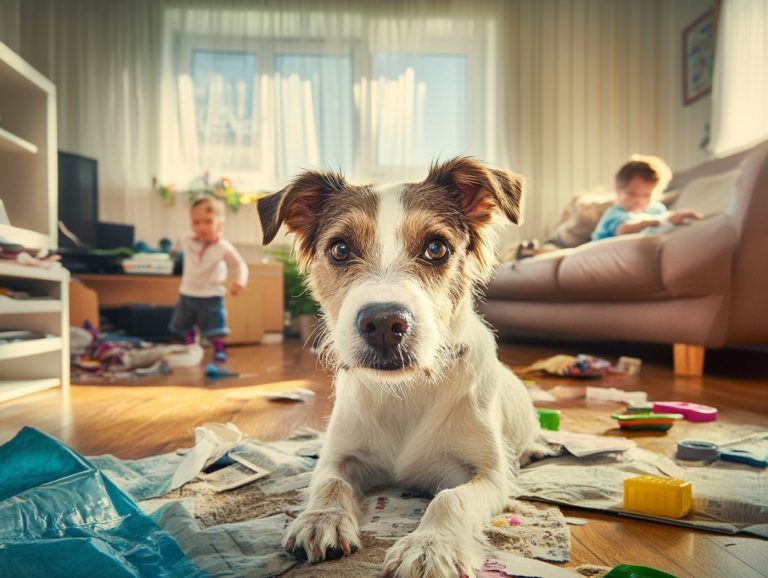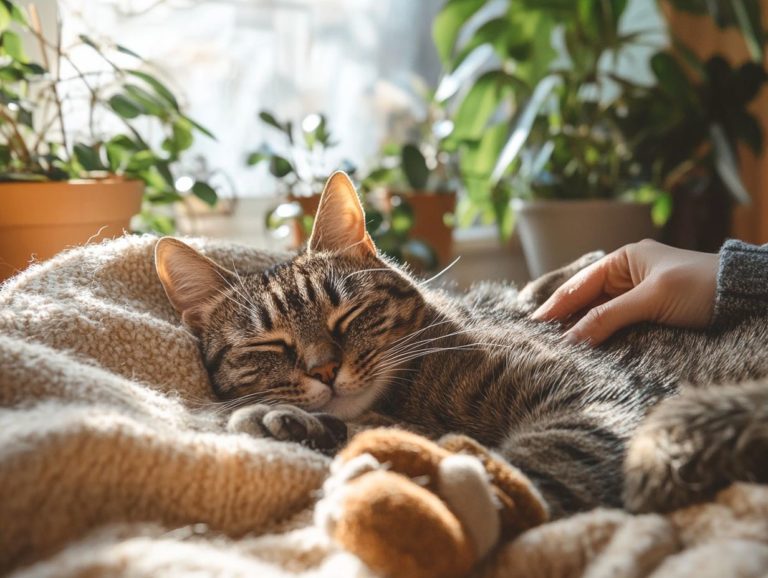How to Use Positive Reinforcement to Manage Anxiety
Anxiety can often seem like an insurmountable wave. However, grasping its origins and learning effective coping strategies, especially through positive reinforcement, can truly transform your experience.
Let s explore what anxiety is, its underlying causes, and how different reinforcement styles affect your ability to manage it. You will discover the distinct effects of negative and positive reinforcement, highlighting how the latter can serve as a powerful ally in easing anxiety and enhancing emotional well-being.
By offering practical techniques, motivational strategies, and insightful tips for everyday life, our goal is to empower you to improve your coping skills and overall well-being. Join us as we reveal the substantial benefits of positive reinforcement in navigating anxiety more effectively.
Contents
- Key Takeaways:
- Understanding Anxiety
- Negative Reinforcement vs. Positive Reinforcement
- Differences and Effects on Anxiety
- Using Positive Reinforcement to Manage Anxiety
- Incorporating Positive Reinforcement into Daily Life
- Benefits of Positive Reinforcement for Anxiety Management
- Frequently Asked Questions
- What is positive reinforcement and how can it be used to manage anxiety through effective strategies?
- How can I identify the behaviors or coping strategies that I want to reinforce?
- What are some examples of positive reinforcement for managing anxiety and improving self-esteem?
- How often should I use positive reinforcement for managing anxiety?
- What should I do if my coping strategies or behaviors are not effective?
- Can positive reinforcement be combined with other anxiety management methods?
Key Takeaways:

- Anxiety is a common and complex emotion that can be managed through positive reinforcement techniques and effective strategies.
- Positive reinforcement promotes desired behaviors and reduces negative ones, leading to improved coping skills and overall well-being.
- Incorporating daily positive reinforcement practices, such as positive self-talk, rewarding yourself for progress, and parental reinforcement, can help reduce anxiety and encourage a more positive mindset.
Understanding Anxiety
Understanding anxiety is essential to recognize its impact on individuals, especially children facing Generalized Anxiety Disorder, a condition characterized by excessive worry. Anxiety shows itself as a complex emotional response, marked by feelings of worry, fear, and apprehension about future events.
This can significantly affect how you feel emotionally and influence your behavior patterns. The relationship between anxiety and mental health is intricate, shaping coping strategies and self-esteem, which in turn leads to various behavioral outcomes and communication styles.
What is Anxiety and its Causes?
Anxiety is a natural emotional response, but it can become problematic when it disrupts your daily functioning and emotional well-being. It can arise from various sources, including genetic predispositions, environmental stressors, and learned behavior patterns, impacting your mental health.
You may encounter different types of anxiety disorders, such as generalized anxiety disorder, social anxiety disorder, and panic disorder. Each presents symptoms like excessive worrying, avoidance behaviors, and panic attacks. These conditions can significantly impact your ability to engage in social interactions and lead to changes in your communication styles and emotional responses.
For example, children with anxiety might withdraw, altering their interaction habits. In contrast, adults might experience increased irritability or a tendency to over-explain themselves. Knowing how these changes affect behavior is key to addressing the broader implications anxiety can have on your relationships, personal development, and overall mental health.
Negative Reinforcement vs. Positive Reinforcement
Negative reinforcement and positive reinforcement are crucial concepts in changing behavior, rooted in the principles of operant conditioning. These concepts play a significant role in shaping behavior and emotional responses.
Negative reinforcement involves removing an unpleasant stimulus to encourage desired behavior, while positive reinforcement introduces a rewarding outcome to promote an increase in behavior. Understanding these principles lays a solid foundation for developing effective strategies, especially in child-rearing and behavior change.
Now that you understand anxiety and its management, why not start implementing some of these positive affirmations for anxiety in your daily life? You can take steps towards easing anxiety and enhancing your emotional well-being.
Differences and Effects on Anxiety

Understanding the nuances between negative and positive reinforcement is essential for grasping their effects on anxiety and behavior. Positive reinforcement boosts self-esteem and cultivates effective coping strategies by rewarding desired actions. In contrast, negative reinforcement can unintentionally increase anxiety by perpetuating avoidance behaviors and leading to negative consequences through the alleviation of discomfort.
This distinction becomes clear when exploring case studies of individuals facing anxiety disorders. One study showcased a young woman who thrived under a structured reward system that encouraged her to confront social situations. This ultimately enhanced her confidence and gradually diminished her anxiety.
In another case, a man continued to sidestep public speaking, finding immediate relief in avoidance. This only served to entrench his anxiety cycle and reinforce anxiety-provoking behaviors.
Explore the fascinating ways our minds work to see how positive and negative reinforcement can change our lives. Psychological mechanisms, such as conditioned responses, emotional triggers, and reinforcement sensitivity theory, profoundly influence mental health outcomes.
Using Positive Reinforcement to Manage Anxiety
Employing positive reinforcement strategies is an exceptionally effective approach to managing anxiety, particularly through methods like using clicker training to alleviate anxiety, especially in therapeutic settings like Cognitive Behavioral Therapy and therapy sessions.
By rewarding desired behaviors, you can facilitate meaningful behavioral change. This ultimately enhances your emotional well-being, significantly lowering your anxiety levels and leading to positive outcomes.
Techniques and Strategies
Several techniques and strategies can significantly enhance your use of positive reinforcement in managing anxiety and improving mental health. For example, using treats effectively in anxiety training can help. By setting clear, achievable goals and implementing self-reward systems, you can create a motivating environment that fosters desired behavior patterns and supports client progress.
Establishing specific, measurable expectations allows you to understand what is needed for success. For example, if you re working to overcome social anxiety, break your goal into manageable steps, such as initiating a conversation with a coworker.
Tying reward systems to these milestones can make your progress feel rewarding. Consider treating yourself to a favorite activity after achieving a goal or receiving a good grade on a project.
Feedback communication is vital in this process, especially in a therapeutic context. Regularly discussing which strategies are effective or need adjustment helps you tailor your approach to fit your personal preferences and circumstances. This promotes a more adaptive and supportive framework for your mental wellness.
Incorporating Positive Reinforcement into Daily Life
Incorporating positive reinforcement into your daily life can significantly enhance emotional well-being and shape behavior patterns, especially in children. Additionally, utilizing obedience training to ease anxiety can further contribute to anxiety reduction.
By consistently applying practical tips and examples, including screen time management and rewards, you can create an environment that nurtures desired behaviors while effectively managing anxiety.
Practical Tips and Examples

Utilizing positive reinforcement in child-rearing can lead to big changes in behavior and the outcomes you desire. For example, when you praise your child for completing their homework, you not only enhance their motivation but also boost their self-esteem.
This reinforces the essential role of education in their lives and influences their learning tendencies. Offering rewards for achievements whether it’s a small treat or a special privilege can significantly motivate your child to reach their goals.
You might consider implementing behavior charts, which are charts that help kids see their progress and earn stickers or stars for positive actions. This instills a sense of responsibility and accountability, cultivates desirable behaviors, and reinforces positive consequences.
These strategies create a nurturing environment where your child feels valued and recognized for their efforts. By fostering such an atmosphere, you can elicit positive emotional responses, helping your child associate learning and good behavior with feelings of happiness and accomplishment.
Benefits of Positive Reinforcement for Anxiety Management
Discover how positive reinforcement for anxious pets can dramatically change how you manage anxiety! The benefits of this approach in managing anxiety are remarkable, enhancing your coping skills, self-esteem, and overall well-being.
By actively encouraging desired behaviors, you can experience improved emotional responses and gain a deeper understanding of your anxiety triggers.
This approach also helps reduce negative consequences.
Improved Coping Skills and Overall Well-Being
Improved coping skills and overall well-being emerge as significant benefits when you apply reinforcement strategies in therapy. These techniques enhance your desired behaviors and empower you to manage anxiety-provoking situations more effectively.
As you gradually reinforce positive behaviors, you learn to replace anxious responses with constructive strategies. Take, for example, a young woman struggling with social anxiety; through consistent reinforcement of her accomplishments, she began initiating conversations in social settings, showcasing her amazing progress.
Testimonials from participants in various therapeutic programs reveal dramatic shifts in their emotional well-being. Anxiety levels decreased significantly, allowing them to engage more fully in life.
Such transformative experiences demonstrate how applying these strategies can empower you to navigate your challenges with increased confidence and resilience, thanks to effective therapy techniques.
Frequently Asked Questions
What is positive reinforcement and how can it be used to manage anxiety through effective strategies?

Positive reinforcement is a technique used to encourage desired behaviors, such as coping strategies for anxiety, by providing rewards or positive consequences. To effectively manage anxiety in pets, you can explore how to use rewards to train anxious pets, reinforcing behaviors that reduce anxiety.
How can I identify the behaviors or coping strategies that I want to reinforce?
Start by keeping track of your anxiety triggers and the activities or behaviors that help you cope. This can help you identify which behaviors or strategies are most effective for you and should be reinforced.
What are some examples of positive reinforcement for managing anxiety and improving self-esteem?
- Praise
- Treats
- Privileges
- Activities that bring joy or relaxation, such as taking a walk in nature
- Playing video games
- Listening to music
- Spending time with loved ones
All of these can enhance emotional well-being.
How often should I use positive reinforcement for managing anxiety?
Use positive reinforcement consistently, especially at the start. This helps change behavior patterns and encourages the outcomes you want.
As you reinforce desired behaviors, you can reduce how often you do it. However, continue to provide reinforcement to keep those positive changes in place.
What should I do if my coping strategies or behaviors are not effective?
If your coping methods aren t managing your anxiety, it s crucial to seek guidance from a therapist or counselor. They can help you find better ways to cope and provide the support you need.
Can positive reinforcement be combined with other anxiety management methods?
Absolutely! Positive reinforcement works well with methods like mindfulness and relaxation exercises. These approaches can help you change negative thoughts and behaviors effectively.
Using them together promotes lasting change and reinforces their effectiveness.






